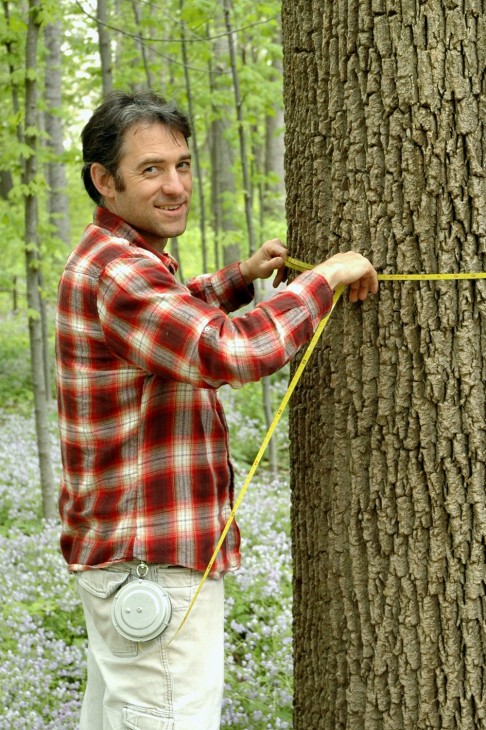In May, the Center for Tropical Forest Science-Smithsonian Institution Global Earth Observatory is moving from its headquarters at Harvard University to the Smithsonian’s National Museum of Natural History in Washington, D.C. The move enhances coordination efforts for the 46-plot research network, which partners with more than 75 institutions in 21 countries, including the Smithsonian’s Natural History Museum, the Smithsonian Conservation Biology Institute and the Smithsonian Environmental Research Center.

Daniel Johnson, a biology graduate student at Indiana University, measures the diameter of a white ash tree in the University’s Lilly-Dickey Woods. The 550-acre woods were recently added to CTFS-SIGEO’s global network of forest research plots. (Photo by F. Collin Hobbs)
CTFS-SIGEO is a global network of forest research plots committed to the study of tropical and temperate forest function and diversity. The multi-institutional network includes plots across the Americas, Africa, Asia, and Europe, with a strong focus on tropical regions. Ecologists at the Smithsonian Tropical Research Institute established the first forest dynamics plot on Barro Colorado Island in the Panama Canal in 1980.
Stuart J. Davies, CTFS-SIGEO director and senior staff scientist at the Smithsonian Tropical Research Institute, will make the move along with David Kenfack, CTFS-SIGEO Africa Program coordinator. Davies sees the need for increased presence at the Smithsonian in Washington, D.C. as the network continues to build partnerships within different Smithsonian units.
The scale and intensity of the CTFS-SIGEO research program remains unprecedented in forest science. Scientists monitor the growth and survival of about 4.5 million trees of approximately 8,500 species in 21 different countries. The work aims to increase the scientific understanding of forest ecosystems, guide sustainable forest management and natural-resource policy, monitor the impacts of climate change, and build capacity in forest science. Most recently CTFS-SIGEO added the Lilly-Dickey Woods–a 550-acre forest in Brown County Indiana that is a research and teaching preserve for Indiana University–to its network of forest research plots.
Because of its extensive biological monitoring, unique databases, and the expertise of its partners, CTFS-SIGEO enhances society’s ability to evaluate and respond to the impacts of global climate change. Monitoring so many forest plots at once is providing a comprehensive, yet locally detailed perspective on how the world’s forests are being transformed by global change. Research on tropical forest dynamics continues, but is joined by new initiatives studying carbon fluxes, temperate forests, ecosystem services, and biodiversity. CTFS-SIGEO and its many institutional partners are leveraging huge intellectual horsepower to transform our understanding of forest-ecosystem structure and function. The network has been so successful that the Smithsonian is now planning to extend its system of earth observatories to the near shore marine realm.
–Source: The Plant Press, newsletter of the Department of Botany, National Museum of Natural History.





